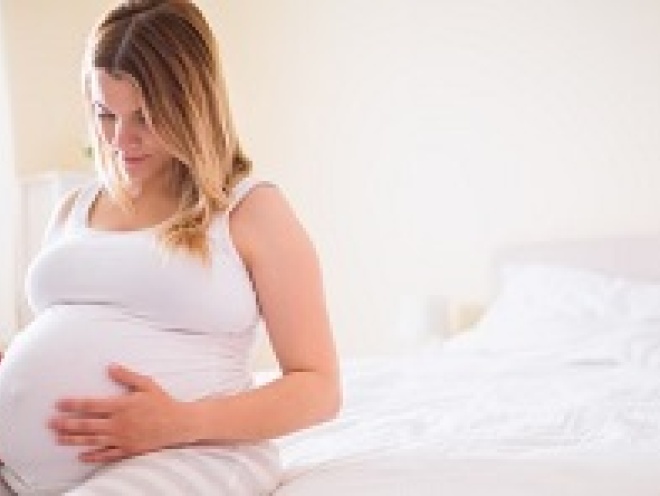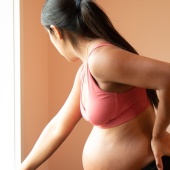Read about the causes and how to reduce the discomfort of pelvic, hip and back pain in pregnancy.
Find out what pelvic girdle pain is, the symptoms and how to cope with PGP in pregnancy and your options for birth.
What is pelvic girdle pain (PGP)?
Pelvic girdle pain (PGP) is the general term for all pelvic pain. It includes pubic pain - previously called symphysis pubis dysfunction (SPD). PGP includes pain anywhere from the lower back down to the thigh, either at the front or back (RCOG 2015).
The pain may range from a mild ache to severe pain that limits your daily activities. This may start at any time during pregnancy, labour or in the weeks after giving birth (POGPH 2015).
Women often feel that PGP affects their daily life, and that their emotional and mental health can suffer (Mackenzie et al 2018). Support is available if you need it, especially if you feel low or isolated because of your PGP (Pelvic Partnership 2016).
"For most women, early diagnosis and treatment should stop symptoms from getting worse, relieve your pain and help you continue with your normal everyday activities" (RCOG 2015)
What causes pelvic girdle pain (PGP)?
It’s hard to say what causes some women to develop PGP and not others (POGPH 2015). The main reasons seem to be a history of previous lower back, pelvic girdle or joint pain, hypermobility syndrome and/or previous trauma to the pelvis (RCOG 2015).
Poor muscle function in the back and pelvis at the beginning of pregnancy is also related to severe pain and disability throughout pregnancy (Shivonen et al 1998).
Symptoms of pelvic girdle pain (PGP)
Pelvic, Obstetric and Gynaecological Physiotherapy (POGP) highlight the following common signs and symptoms:
- Difficulty walking (a waddling gait).
- Pain when putting weight on one leg, such as climbing stairs.
- Pain and/or difficulty in straddle movements, such as getting in and out of the bath.
- Clicking or grinding in the pelvic area.
- Limited and painful hip abduction. (Hip abduction is the movement of the leg away from the middle of the body, such as when you step to the side or get out of a car.)
- Difficulty lying in some positions, such as on your side.
- Pain during normal activities and/or pain/difficulty during sex.
(POGPH 2015, RCOG 2015)
Symptoms can increase through pregnancy as the baby grows. This is because of changes in the body’s centre of gravity, and therefore posture. It usually occurs in pregnancy due to the hormone 'relaxin' softening the ligaments in your body. This allows your pelvis to open up and make room for your baby to be born.
Coping with pelvic girdle pain in pregnancy
The condition is usually diagnosed after a thorough assessment of the pelvic joints and spine. Your healthcare team will be able to refer you to a specialist physiotherapist (POGPH 2015).
Getting a diagnosis as early as possible can help minimise any pain and avoid long-term discomfort (RCOG 2015).
Many women have found that making small changes to everyday activities can reduce their discomfort. POGP suggests trying the following:
- Remain active within the limits of what you find comfortable and can manage. Avoid activities that you know makes the pain worse.
- Accept offers of help and involve your partner, family and friends day-to-day.
- Rest more frequently or sit down for activities that normally involve standing, e.g. ironing.
- Avoid standing on one leg so try dressing sitting down, for instance.
- Consider alternative sleeping positions, such as lying on one side with pillows between your legs for comfort. Turn ‘under’ when turning in bed, or turn over with knees together and squeeze your bum.
- Try different ways to climb stairs. You could try going upstairs one leg at a time with the most pain-free leg first and the other leg joining it on the step.
- Plan the day by bringing everything you need downstairs in the morning and set up changing stations both up and downstairs. You might find a rucksack helpful to carry things around the house, especially if you have to use crutches.
- Avoid activities that involve asymmetrical positions of the pelvis, such as sitting cross-legged, reaching, pushing or pulling to one side, and bending and twisting to lift or carrying anything on one hip.
- Consider alternative positions for sex, such as lying on the side or kneeling on all fours.
- Organise hospital appointments for the same day if possible, such as combining appointments for antenatal care and physiotherapy.
(POGPH 2015, RCOG 2015)
Planning birth with pelvic girdle pain
Many women can have a spontaneous vaginal delivery if they want to. Talk to your midwife about your pain relief options, as well as alternative positions for birth, such as supported kneeling or side lying with pillows/knees to chest. Using a birth pool may help you move around more freely without pain (RCOG 2015).
A caesarean section is not usually needed or recommended for women with PGP, as this might slow down your recovery (RCOG 2015).
What treatment will I be offered for PGP?
Your healthcare provider will refer you to a physiotherapist who will make an assessment and put together a treatment plan. This could include:
- Advice on avoiding activities that make your pain worse and alternatives.
- Exercises, including those to strengthen your pelvic floor and abdominal muscles.
- Treatment by an osteopath, chiropractor or physiotherapist who specialises in PGP.
- Therapy that includes use of hot and cold packs, hydrotherapy, use of a TENS machine or acupuncture (Vermani et al 2009).
- Support belts can be effective if used regularly for short periods (Bertiut et al 2018).
- Using crutches.
- If the pain is severe then regular pain relief medication might be needed. Your GP can discuss options with you.
(POGPH 2015, RCOG 2015)
While PGP in pregnancy is common, it isn’t normal (POGPH 2015). You should always seek help if you think you are suffering with it. It is a treatable condition that you can get support to manage.
This page was last reviewed in January 2019.
Further information
Our support line offers practical and emotional support with feeding your baby and general enquiries for parents, members and volunteers: 0300 330 0700.
We also offer antenatal courses, which are a great way to find out more about birth, labour and life with a new baby.
The POGP (Pelvic Obstetric and Gynaecological Physiotherapy) is a UK-based professional network affiliated to the Chartered Society of Physiotherapy, which provides useful information on PGP.
The Pelvic Partnership is a charity, which aims to pass on information about pelvic girdle pain based on research evidence and on other women’s experience.
Bertuit J, Van Lint C, Rooze E, Feipel V (2018) Pregnancy and pelvic girdle pain: analysis of pelvic belt on pain. Journal of clinical nursing, 27(1‐2), e129‐e137 https://www.cochranelibrary.com/central/doi/10.1002/central/CN-01604547/full#abstract
Mackensie J, Murray E, Lusher J (2018) Women's experiences of pregnancy related pelvic girdle pain: A systematic review. Midwifery 56:102-111 https://www.ncbi.nlm.nih.gov/pubmed/29096278
Pelvic Partnership (2016) Symptoms of PGP https://pelvicpartnership.org.uk/what-is-pgp-symptoms-of-pgp/
POGPH (2015) Pregnancy related pelvic girdle pain. Guidance for health professionals.
RCOG (2015) Pelvic Girdle Pain and Pregnancy. https://www.rcog.org.uk/globalassets/documents/patients/patient-information-leaflets/pregnancy/pi-pelvic-girdle-pain-and-pregnancy.pdf
Sihvonen T, Huttunen M, Makkonen M, Airaksinen O. (1998) Functional changes in back muscle activity correlate with pain intensity during pregnancy. Phys Med Rehab 79:1210-12 https://www.archives-pmr.org/article/S0003-9993(98)90264-7/pdf
Vermani et al (2009) Pelvic Girdle and Low Back Pain in Pregnancy: A review. http://www.salempainandspine.org/wp-content/uploads/2013/Pregnancy_Lowbackpain.pdf
Wong J, McGregor A (2018) Spatiotemporal gait changes in healthy pregnant women and women with pelvic girdle pain: A systematic review. J Back Musculoskelet Rehabil. 2018;31(5):821-838. https://www.ncbi.nlm.nih.gov/pubmed/29865027




